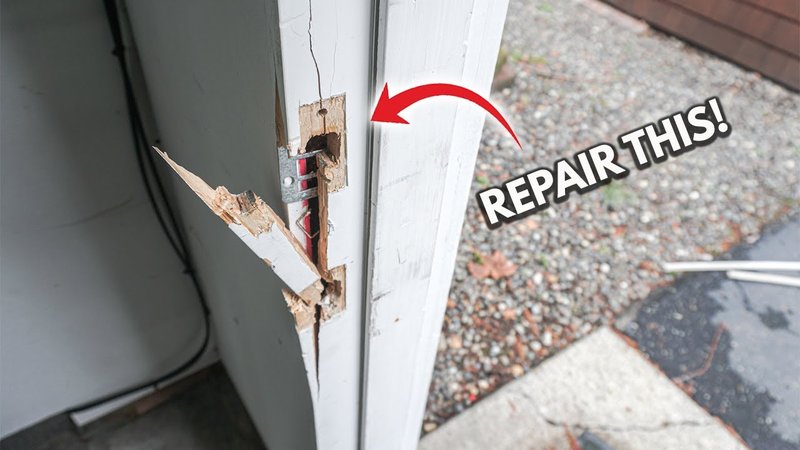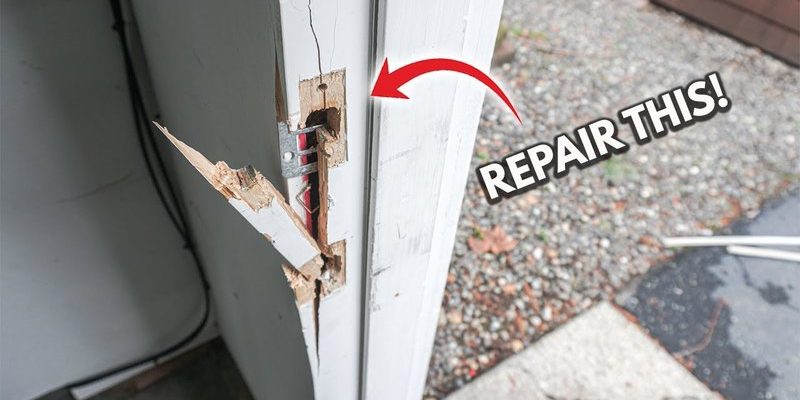
Let me explain what’s really going on. Your exterior door and jamb are like puzzle pieces designed to fit together perfectly. But over time, weather, settling, or even a few slammed doors can knock things out of sync. Suddenly, your front door starts acting more like a swinging saloon door than the solid, secure barrier you want. The good news? With a little troubleshooting—plus some patience—you can fix a loose exterior door without calling in a pro.
What Causes an Exterior Door to Become Loose in the Jamb?
Honestly, a door doesn’t just wake up one morning and decide to get wobbly. There are a handful of common culprits. First, the *hinges* might be loose or worn out. Metal can bend, screws can strip, and over time, the whole set-up starts to sag. If your door feels like it’s dropping down or pulling away from the frame, hinge trouble is a likely suspect.
Another big cause is *settling*. Houses are like living things—they expand, contract, and shift with the seasons. If your home settles unevenly, the door frame can twist or pull out of square. That leaves gaps, uneven contact, and a door that just doesn’t “sit” right in the jamb anymore. You might see more daylight around the edges or feel a chilly draft.
Weather can also play a part. Wood swells and shrinks with temperature and humidity, especially after heavy rain or a hot, dry spell. Over time, repeated cycles of swelling and shrinking can loosen screws, stretch out mortises (the slots cut for hinges), or even crack the jamb itself.
How to Diagnose Why Your Door Is Loose
You might be wondering, “How do I know what’s *actually* wrong?” Before you break out the hammer—or call your handy uncle—let’s go step by step. First, *check the hinges*. Open your door halfway and gently lift it by the doorknob. If it moves up and down a lot, the hinges or screws might be loose.
Next, look for gaps around the door. Is the spacing even from top to bottom? If the gap is wider at the top or bottom, your frame could be out of alignment. Run your hand along the edges to feel for drafts. If you can feel cold air or see daylight, that’s a visual cue your door isn’t sealing right.
Some folks skip this: *Test your latch and deadbolt*. Do they catch smoothly? Or do you have to tug on the door, wiggle it, or push hard to get the lock to engage? If so, the door isn’t sitting where it’s supposed to in the jamb. That’s a giant red flag for alignment issues. Keep an eye out for rubbed paint or scuffed metal near the latch plate—another sign things aren’t lining up.
Fixing Loose Hinges: Tighten, Replace, or Reset?
Most loose exterior doors start with the hinges. Grab a screwdriver and check each hinge screw. If any feel loose, try tightening them. If they just spin without gripping, the screw hole might be stripped out. Here’s the thing: Stripped screws won’t hold the hinge tight, and you’ll keep fighting a saggy door.
One classic trick is to remove the screw, stick a couple of toothpicks (or a matchstick, with the tip removed) dipped in wood glue into the hole, and break them off flush. Screw back in. This fills the gap and gives the screw something solid to bite into again.
If your hinges are bent or rusted, it’s time to replace them. Take one hinge off at a time to avoid unhinging the entire door. Match the size and style—most exterior doors use 3.5″ or 4″ hinges, often with four holes per plate. Swapping in fresh hinges can often *reset* the door’s alignment and take up extra slack.
Dealing with a Warped or Out-of-Square Door Frame
Sometimes, the door itself isn’t the main character—it’s the frame causing drama. An exterior door jamb can bow, twist, or pull away from the wall, especially on older homes. If tightening the hinges didn’t solve it, the *jamb* might be out of square.
Check with a carpenter’s square or just by sighting down the edge. Is the jamb flush along its length? If it’s bowed out, you might be able to pull it back into place by tightening the screws holding the frame to the wall studs. In bad cases, you’ll need to shim behind the jamb at the hinge locations—think of it like putting a small wedge behind the hinge leaf to push the frame into better alignment.
If you’re adding shims, loosen the hinge screws, slide in a shim (thin piece of wood or cardboard), then retighten. This nudges the hinge and door into a better position.
If the frame is way out of line, or the wall itself has shifted, call in a pro—a little DIY patience goes a long way, but some jobs aren’t worth fighting alone.
Adjusting the Strike Plate for a Tighter Fit
Don’t overlook the *strike plate*. This metal plate on the jamb is what keeps your latch or deadbolt secure. If the door feels loose even after you adjust the hinges, sometimes the strike plate is simply out of sync.
First, see if the latch lines up with the hole in the strike plate. If it doesn’t, you might need to move the plate slightly. Unscrew it, shift it up or down just a hair, and screw it back in. This tiny adjustment is often all it takes to get your lock to catch firmly.
For a really loose door, consider adding a *shim* behind the strike plate. Folding a thin piece of cardboard and slipping it behind the plate before screwing it in can bring it just a touch closer to the door. This is especially helpful if your latch doesn’t quite reach or feels sloppy when closed.
And honestly, if you’re dealing with a major gap—say, more than 1/4 inch—adding weatherstripping is a smart backup. Foam or rubber weatherstrip not only tightens the seal but also helps with drafts and sound.
When to Replace Hardware vs. Repairing What’s There
Here’s a debate every DIYer faces: Do you *fix* what’s there, or just swap it out for new hardware? If your door’s hinges or strike plate are rusted, bent, or missing screws, you’ll spend more time fiddling than it’s worth. New hardware isn’t expensive, and installing a fresh set can give your door a whole new lease on life.
But if everything looks solid—no cracks, no heavy rust—repairing is totally fair game. Fix stripped screws with wood glue and dowels, bend a hinge back if it’s only slightly off, and tighten everything up. There’s something satisfying about keeping original hardware going, especially on older homes.
For security, though, don’t mess around: If your deadbolt or strike plate isn’t holding solidly in the wood, upgrade to a reinforced strike plate with longer screws that go deep into the framing. It’s a small investment for much better peace of mind.
Weatherstripping and Door Sweeps: The Finishing Touches
Even after tightening everything up, you might still notice a subtle draft—or maybe a sliver of daylight. That’s where weatherstripping and door sweeps come in. These aren’t just for winter; a snug exterior door saves energy all year and cuts down on noise and dust.
For the sides and top of your door, adhesive foam weatherstripping works great. Cut it to size, peel off the back, and stick it inside the jamb where the door presses when closed. If you see old, crumbling weatherstrip (or none at all), it’s time for an upgrade.
The bottom of the door is notorious for leaks and rattling. Door sweeps—usually a strip of rubber or bristles screwed to the door’s bottom—seal the gap where wind and bugs love to sneak in. Installing one is surprisingly easy, and you’ll feel the difference the next time a gust tries to come through.
Pro tip: If you’re pairing a universal weatherstrip kit with your original door, double-check the thickness before sticking anything down for good. Too-thick weatherstripping can make your door hard to close, while too-thin won’t seal out drafts.
When to Call a Pro (and When You Don’t Need To)
Let’s be honest—sometimes you can do everything right and the door still won’t fit tight. Maybe your whole jamb is crooked, or you can’t get the latch to engage no matter what you try. If the frame is splitting, or if you see signs of rot or major damage, bringing in a professional is the smartest move.
But most of the time, a loose exterior door just needs a little troubleshooting and some basic tools. Tightening screws, adding a shim, or adjusting the strike plate is well within reach for a beginner. If you’re patient and double-check your work, you’ll learn a lot—and save money too.
If you do hire a pro, ask them to show you what they’re doing. Not only can you understand the fix, but you’ll be able to spot issues sooner next time and maybe do it yourself down the road.
Closing Thoughts: Enjoy Your Solid, Secure Entryway
So, that’s the whole story with an exterior door that’s too loose in the jamb. At first, it can be surprisingly frustrating—like, how can such a simple thing drive you a little bit nuts? But with a patient, step-by-step approach, you can tighten things up and restore that solid, satisfying “thunk” when you close your door. Whether you’re dealing with a classic Masonite entry, a JELD-WEN fiberglass model, or a decades-old wood door, most fixes are easier than they seem. Take your time, trust your eyes and hands, and enjoy the peace of mind that comes with a job well done. Your door (and your heating bill) will thank you.
